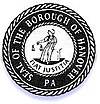Hanover, Pennsylvania
| Hanover, Pennsylvania | ||
|---|---|---|
| Borough | ||
| Borough of Hanover | ||

The Famous Hot Wiener restaurant in downtown Hanover
|
||
|
||
| Nickname(s): Black Rose Community, Snack Capital of the World, Rogue's Roost | ||
| Motto: Fiat Justitia (Latin: Let Justice be Done) |
||
 Location in York County and the state of Pennsylvania. |
||
| Coordinates: 39°48′26″N 76°59′5″W / 39.80722°N 76.98472°WCoordinates: 39°48′26″N 76°59′5″W / 39.80722°N 76.98472°W | ||
| Country |
|
|
| State |
|
|
| County | York | |
| Founded | 1763 | |
| Incorporated | March 4, 1815 | |
| Founded by | Richard McAllister | |
| Named for | German City of Hannover | |
| Government | ||
| • Type | Mayor-Council | |
| • Mayor | Ben Adams | |
| • Borough Manager | Florence Ford | |
| • City Council |
Members
|
|
| Area | ||
| • Total | 3.71 sq mi (9.6 km2) | |
| • Land | 3.71 sq mi (9.6 km2) | |
| Elevation | 614 ft (187 m) | |
| Population (2010 census) | ||
| • Total | 15,289 | |
| • Estimate (2014) | 15,454 | |
| • Density | 4,117.7/sq mi (1,589.9/km2) | |
| Time zone | Eastern (UTC-5) | |
| • Summer (DST) | Eastern (UTC-4) | |
| ZIP code | 17331, 17332, 17333, 17335 | |
| Area code | 717 | |
| FIPS code | 4232448 | |
| GNIS feature ID | 1215748 | |
Hanover is a borough in York County, Pennsylvania, 19 miles (31 km) southwest of York and 54 miles (87 km) north-northwest of Baltimore, Maryland and is 5 miles (8.0 km) north of the Mason-Dixon line. The town is situated in a productive agricultural region. The population was 15,289 at the 2010 census. The borough is served by the 717 area code and the Zip Codes of 17331-34. Hanover is named after the German city of Hannover.
In 1727, John Digges, an Irish nobleman of Prince George's County, Maryland, obtained a grant of 10,000 acres (40 km2) of land where Hanover is now located from Charles Calvert, the fourth Lord Baltimore. The area was called Digges Choice, and in 1730, a group of Catholics started the settlement that became known as the Conewego Settlement. Settlers from both Maryland and Pennsylvania began moving into the area in the 1730s. At this time, the northern border of Maryland and the southern border of Pennsylvania did not agree with each other, and the area that is now Hanover was in the disputed area claimed by both states. This led to numerous disputes about property ownership from the 1730s until 1760. The dispute was settled when Maryland and Pennsylvania hired British experts Charles Mason and Jeremiah Dixon to survey what became known as the Mason–Dixon Line. This line was surveyed between 1763 and 1767, and put an end to decades of disputes over rights and ownership.
In 1745, a Scotch-Irishman named Richard McAllister purchased the tract of land upon which the original town of Hanover was built. McAllister was a Presbyterian who had recently migrated from the Cumberland Valley. Hanover at that time was covered with a dense forest of hickory, walnut, and oak trees. McAllister erected a log house at what is now the corner of Baltimore and Middle streets, and opened a store and tavern. In 1763, McAllister divided his farm into lots and founded the town of Hanover. German settlers nicknamed the settlement "Hickory Town" after the thick groves of hickory trees that grew in the area. The name Hanover was suggested by Michael Tanner, who was one of the commissioners who laid out York County in 1749 and owned large tracts of land southeast of the town. Tanner's choice of the name came from the fact that he was a native of Hanover, Germany. The town's founders, who wanted to please the German settlers, agreed to the name. Hanover was also sometimes referred to as "McAllister's Town" in its early years.
...
Wikipedia

